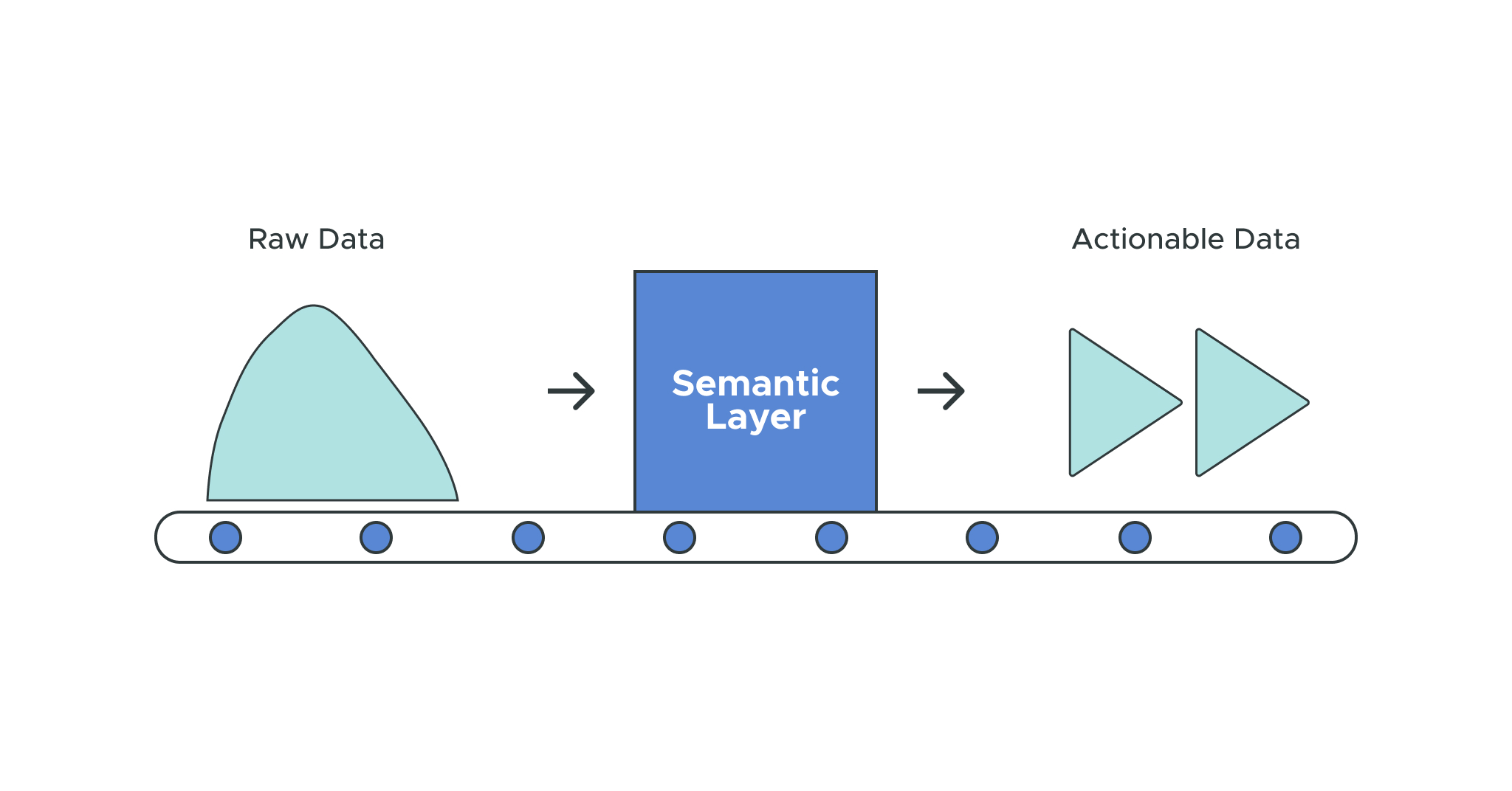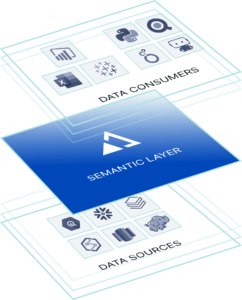June 1, 2021
How to Use a Semantic Layer for Data and Analytics
As intelligent automation technologies become more prevalent and sophisticated, the need for a semantic layer to provide the data necessary for enterprise operations is becoming increasingly important. This includes improving process and task automation development, data refinement and optimization, interpreting and acting on streaming data, and using machine learning.
This article will discuss the benefits of using a semantic layer to enable smarter, faster process and task automation as well as interaction and optimization. We will look at some examples of how the semantic layer, including the physical dataset created by the layer, improves intelligent automation performance accuracy, productivity, and feedback / improvement.
What is Intelligent Automation (IA)?
Intelligent automation (IA) is the use of automation technologies – typically artificial intelligence (AI), business process management (BPM), and robotic process automation (RPA) – to streamline and scale decision-making across organizations. Intelligent automation simplifies processes, frees up resources and improves operational efficiencies, and it has a variety of applications. For example, an enterprise manufacturer may use IA to speed up production or reduce the risk of human error, or use intelligent automation to reduce costs and gain resource efficiencies where repetitive processes exist.
The 3 components of Intelligent Automation
Intelligent automation comprises three core technologies:
- The most critical component of intelligent automation is artificial intelligence, or AI. By using machine learning and complex algorithms to analyze structured and unstructured data, businesses can develop a knowledge base and formulate predictions based on that data. This is the decision engine of IA.
- The second component of intelligent automation is business process management (BPM), also known as business workflow automation. Business process management automates workflows to provide greater agility and consistency to business processes. Business process management is used across most industries to streamline processes and improve interactions and engagement.
- The third component of IA is robotic process automation (RPA). Robotic process automation uses software robots, or bots, to complete back-office tasks, such as extracting data or filling out forms. These bots complement artificial intelligence well as RPA can leverage AI insights to handle more complex tasks and use cases.
The Three Technologies Enabling Intelligent Automation
| Artificial Intelligence | Business Process Management | Robotics Process Management |
| Machine Learning and Algorithms to understand, predict, prescribe and optimize processes and tasks | Workflow automation to provide greater speed, agility and consistency with fewer manual resources and effort | Software robots to complete back-office tasks, such as extracting data, filling out forms and deciding actions |
Four Enabling Analytical Capabilities
To better understand the role of the semantic layer in intelligent automation, it is helpful first to understand the core analytical capabilities underpinning intelligent automation. Intelligent automation leverages four enabling analytics capabilities:
- Computer vision
- Execution automation
- Language interpretation
- Optimization based on thinking & learning
Each analytical capability relies on specific enabling capabilities – all rely on having relevant, refreshed data to perform and improve.
The Four Analytical Capabilities of Intelligent Automation
| Vision | Execution | Language | Thinking and Learning |
| Visual interpretation of data, including pattern detection and classification | Process and Task implementation using deterministic and probabilistic methods | Chatbots that enable voice and text interaction via Natural Language Processing | Optimization of tasks and processes using data and machine learning algorithms |
The Vision analytical capability functions as the “eyes” for automation – providing machines with the ability to interpret and act on visual information. This can be done through the use of sensors or cameras that capture images and machine learning algorithms that can identify and classify objects in those images.
The Execution analytical capability functions as the “hands and legs” of IA. It allows computing programs to accomplish actions in digital environments (e.g., typing, clicking, opening applications, and sending emails). The technologies supporting this capability include smart workflow, low-code platforms, and robotic process automation (RPA).
The Language analytical capability functions as the “voice” – enabling machines to understand and respond to human language. For example, language capabilities include chatbots and other automated translations. This is done through natural language processing.
The Thinking & Learning analytical capability functions as the “brain”, supported by continuous learning analytics capabilities such as machine learning. It gives computers the ability to analyze, create insights, predict, make decisions, and learn / improve. In order for machines to learn, the analytic models need access to large data sets that can be used to train predictive, inferential models and improve them through continuous data feedback. This is typically done through the use of cloud-based services, which support storing large data sets and provide on-demand compute that can scale. This enables expand use cases like streaming data where rapid interpretation and actions from the data are required.
The four (4) core IA analytical capabilities play a vital role in automating entire business processes for companies, such as automating purchase to pay or order to cash processes. By combining the use of the four (4) IA analytical capabilities, companies can automate a plethora of seemingly complex use cases. As a result, effective IA projects typically generate significant incremental improvement at a lower cost, addressing a broad set of use cases. These include improving customer and employee interactions and experiences as well as increasing productivity.
Typical Analytics Capabilities Supporting Intelligent Automation
| Vision | Execution | Language | Thinking and Learning |
| Visual interpretation of data, including pattern detection and classification | Process and Task implementation using deterministic and probabilistic methods | Chatbots that enable voice and text interaction via Natural Language Processing | Optimization of tasks and processes using data and machine learning algorithms |
What is a Semantic Layer?
The Semantic Layer makes data actionable for Intelligent Automation. The semantic layer sits between the raw data source layer and the automation application consumption layer in a typical intelligent automation information system. The semantic layer defines, structures, enhances, integrates and publishes the data used to enable intelligent automation, making it relevant and actionable for humans and machines to understand, interpret and act upon.
The semantic layer sits between data sources and data consumption, enabling effective, consistent business-oriented definition of data models and metrics, including data integrated from multiple data sources. The semantic layer also enables consistent use of data across multiple consumption tools and applications, including for AI and BI. Importantly, the semantic layer also enables automation of data aggregation and optimization of data queries used by the consumption layer.

This is important because it allows machines to go beyond the simple interpretation of data in a literal way. With a semantic layer, machines can understand the context of data and its relationship to other data. This makes it possible for them to perform more complex tasks and to learn from experience.
Without a semantic layer, machines are limited to understanding and acting on data in a very literal way. For example, give a machine learning algorithm a list of images of cats and dogs, and it will identify cats and dogs in new images based on their visual features. In the absence of the semantic layer, the machine would not understand that a dog and cat are both animals or are both pets. A semantic layer can help overcome this limitation by interpreting data in a more human-like way.
The semantic layer works by parsing user requests and translating them into a machine-readable format. This process is known as natural language processing (NLP), and it is the key to making the semantic layer work. NLP is the ability of computers to understand human language in its natural form. It involves breaking down the text into individual words and phrases and then parsing those words and phrases according to their meaning. This process allows the computer to extract the essential information from user requests, without being distracted by irrelevant details.
Once the computer has extracted the essential information from user requests, it can pass it on to the business logic for processing. The business logic then carries out the actual task requested by the user and returns the results back to the user interface.
Therefore, the semantic layer is responsible for translating human language into a machine-readable format and passing user requests on to the business logic for processing. It is an essential component of any AI strategy and plays a key role in making automated tasks possible.
Why Is a Semantic Layer Critical to IA?
A semantic layer is an important part of any AI solution. It is essential for three reasons: first, it ensures that all requests are unambiguous; second, it allows the computer to learn from its mistakes; and third, it enables the democratization of automation technologies.
Unambiguous Requests
An unambiguous request means that the computer can understand exactly what is being asked of it. This is important because it prevents the computer from making mistakes due to misinterpretation of user requests.
It also ensures that the computer can respond consistently and predictably, which is essential for the smooth operation of an automated system. The nature of an unambiguous request also makes it possible for the computer to provide feedback to the user to be sure that their request was understood correctly.
Learning from Mistakes
The second reason why a semantic layer is important is that it allows the computer to learn from its mistakes. This is done by logging all of the requests made to the system and analyzing the results of those requests.
This information can then be used to improve the accuracy of the computer’s interpretation of user requests, as well as to improve the performance of the business logic. The computer can also use this information to learn new tasks and to adapt its behavior in response to user feedback.
Democratizing Technologies for Non-Technical Experts
A semantic layer makes automation more accessible. It increases the connection between people and machines, as less coding and programming expertise is required to use technology.
It enables everyone in any sector to use technology to automate their work activities in a simple, natural way rather than by using programming languages. The semantic layer enables user-friendly interfaces such as drag and drop functionalities or the capacity to build applications using plain human language. It also helps employees better understand how data is structured and used throughout the company.
A semantic layer leads to a higher level of acceptance of automation technologies by people. This contributes to greater ownership and engagement of people and to smoother change management during technology-enabled transformations. It also improves the speed and scale of an automation transformation because more people actively participate in its implementation.
In summary, the implementation of a semantic layer is essential for any IA initiative. By providing a structure for understanding and categorizing information, a semantic layer allows systems to make sense of data and interactions in order to automate tasks. Without this layer, systems would be limited to low-level automation and would not be able to take advantage of the full potential of IA. In addition, a semantic layer is necessary for the adoption of automation technologies by the largest number of people in companies, ensuring the success of automation transformations.
The capabilities of using a Semantic Layer to unleash the power of Intelligent Automation are critical, and include the following:
- Intelligent Workflow – to Automate Data Model and Pipeline Design, including by non-technical resources to accelerate speed-to-insights and productivity
- Enterprise Metric Store and Enterprise Data Model Store – to enable use / reuse of consistent, data definitions to improve data consistency, relevance and refinement
- Data Orchestration – to automate data aggregation and query construction to improve speed to data consumption availability and usability, which is particularly important for IA
- Query Optimization – to improve data query response time and scale, to handle data that can be large, unstructured and streaming as IA needs to action data with low latency


ANALYST REPORT